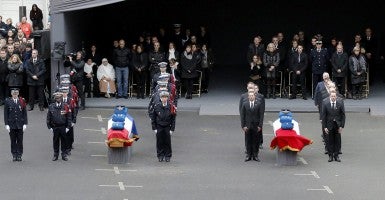Last week’s terrorist attacks in Paris against the Charlie Hebdo cartoonists and a Jewish grocery store that killed 17 people have underscored the rising threats posed by Islamist terrorists inside Western countries.
Since the 1979 Iranian revolution and the rise of al-Qaeda in the 1990s, the launching of terrorist attacks against western targets by radicalized Muslims incited by Islamist revolutionary movements based in the Middle East has been a growing trend. Iranian leader Ayatollah Ruhollah Khomeini called for the murder of novelist Salman Rushdie in 1989 as punishment for writing the book “Satanic Verses,” which he deemed to be blasphemy against Islam. Khomeini’s edict helped incite violence that included attacks on bookstores and the book’s translators, as well as more than 50 deaths, mostly in Turkey and other predominantly Muslim countries.
The terrorists who attacked the Charlie Hebdo staff also claimed to be punishing blasphemy against Islam on behalf of a foreign Islamist power: al-Qaeda in the Arabian Peninsula (AQAP), the al-Qaeda franchise based in Yemen.
AQAP claimed responsibility Wednesday for the atrocity and maintained that the plot had been set in motion by Anwar al-Awlaki, the AQAP leader who was killed in a U.S. drone strike in 2011.
The director of Europol, the European police agency, has confirmed that the two brothers involved in the Charlie Hebdo attack, Said and Cherif Kouachi, had travelled to Yemen for training in 2011 and noted that 3,000 to 5,000 European nationals have traveled to Syria to fight and may pose a similar risk when they return.
Al-Qaeda, which emerged from the cohort of Arab militants who fought the Soviets in Afghanistan in the 1980s, has replicated itself in regional franchises that have thrived by recruiting a new generation of Islamist militants who have joined the fighting in subsequent wars in Algeria, Chechnya, Iraq, Libya, Syria and Yemen.
These Islamist revolutionaries are now waging an inter-linked global insurgency to overthrow governments in all predominantly Muslim countries and can strike targets inside of Western countries, as in Paris.
Law enforcement measures alone cannot defeat this menace. There are simply too many potential terrorists to monitor, let alone pre-empt. And small sleeper cells, like the Kouachi brothers, can bide their time waiting for an opportunity.
It remains unclear how closely the brothers actually worked with AQAP. Although AQAP spokesman Nasr al-Ansi claimed his organization “chose the target, laid the plan, [and] financed the operation.” some terrorism experts surmise that this may have been an after-the-fact attempt to boost the prominence of AQAP. It also is curious that an ally of the brothers, Amedy Coulibaly, who perpetrated the attack on a Jewish grocery store, claimed he acted in the name of ISIS, a rival terrorist group that has broken with the al-Qaeda network.
What is clear is that both terrorist groups, competing for the allegiances of Islamist extremists, have strong incentives to step up attacks on Western targets to enhance their reputations with potential recruits.
The United States needs to take a more proactive stance to counter terrorist groups, divert young Muslims from terrorist paths and isolate Islamist extremists from the majority of Muslims, who reject terrorism.
In addition to soft power, Washington must use hard power in a comprehensive political/military/economic/ideological/intelligence/law enforcement strategy to divide, dismantle and defeat the al-Qaeda terrorist network and its offshoots.
Although the Paris terrorist attacks bear similarities with many previous attacks, they are harbingers of carnage inflicted by a new generation of terrorists operating more brazenly against a wider set of soft targets than in the past.






























